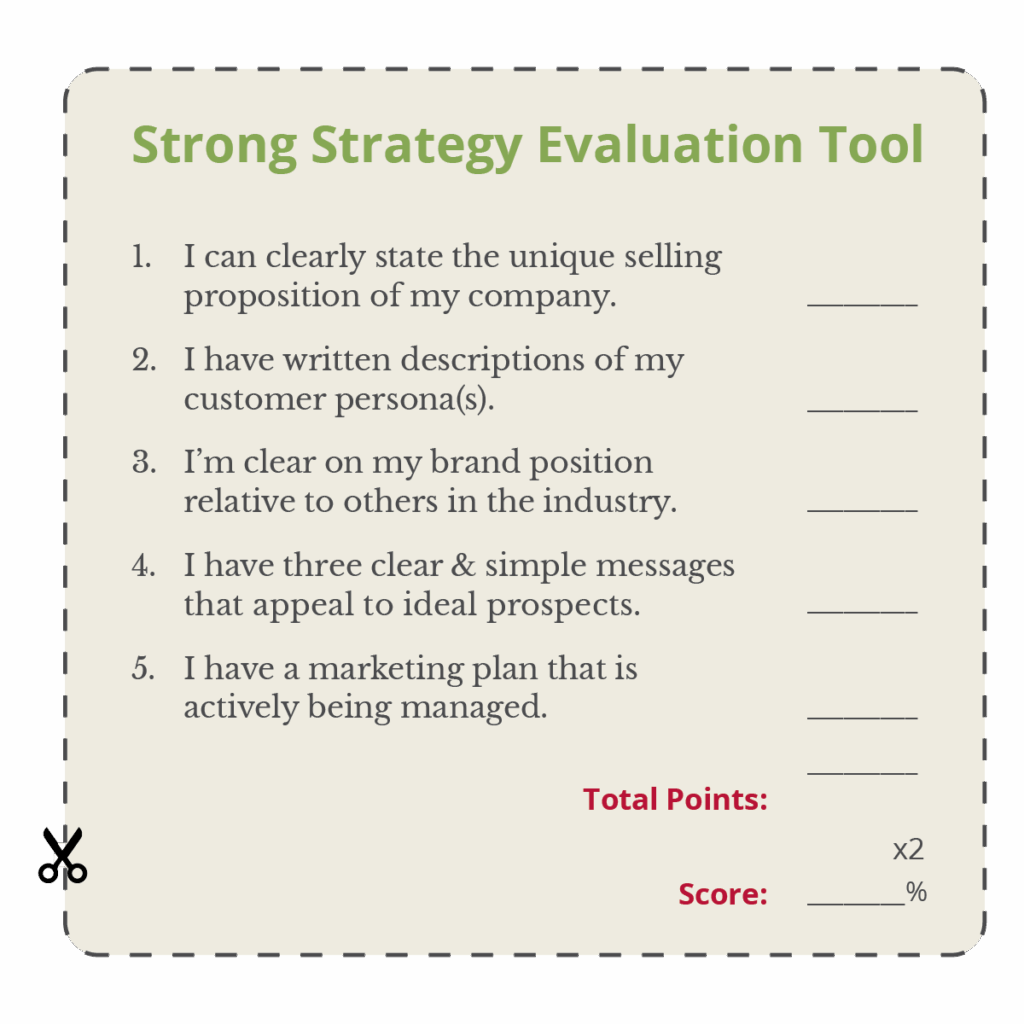Did you ever wish for a rubber mallet when fitting pieces together on a jigsaw puzzle? I’ve wished for one when two pieces look like they really should fit, but they don’t. Maybe a good “thunk” with a mallet is what they need!
Ridiculous, of course! Yet without a strong strategy in business, we may be trying to do something just as silly and futile. An effective
marketing strategy brings customers and businesses together in ways that fit and are mutually beneficial. No forcing is needed. Ideally, the company fits the customer, and the customer fits the company.

What is meant by a strong marketing strategy?
A strong marketing strategy effectively addresses two questions: What makes a business fit with a customer? What makes a customer fit with a business? Marketing strategy is a plan that fits the company to the customer like two puzzle pieces. These two well-matched pieces complete and satisfy the picture, making the connection in a practically seamless interlock.
Research, as described in the previous article of this series, is the means to understanding the shape of the customer puzzle piece.
You can’t carve the customers’ puzzle piece to fit your company; your company must shape itself to match the customers’ needs. However, unlike a jigsaw puzzle, a business must shape itself to match what research reveals to be the customers’ realities.
A business has created a strong strategy when the two pieces fit seamlessly. Sometimes, this is referred to
as a niche market: a hand-in-glove fit between what a customer needs and what the business provides. This sweet spot is what a strong market strategy identifies and maximizes.
Roger L. Martin, in Playing to Win, defined strategy this way: “Strategy is an integrated set of choices that uniquely positions the firm in its industry to create sustainable advantage and superior value relative to the competition.” ¹
Can you see the two puzzle pieces in that quote? While Martin is speaking from the business’s perspective, the “superior value” is solely the customer’s judgment. It is the customer who shows with his wallet whether or not their is in fact “sustainable advantage”.
This hand-in-glove fit is often referred to as a company’s Unique Selling Proposition (USP). The USP is designed to serve a Customer Persona. We will explore each of these terms. Then we will introduce the three essential components of a strong marketing strategy. In the next three articles, we will explore each of these individually.

Unique Selling Proposition
A company’s existence depends on attracting customers who can be helped. Identify what attracts customers to your business and compels them to do business with you. This will help you understand the current strategy at work in your business.
In every business transaction, a problem is solved. A lemonade stand quenches thirst on a hot summer day. An optometrist offers clearer vision. An electrician brings you electricity. Rosewood Marketing helps your business grow.
The problem solved often has a “hard” dimension and a “soft” dimension. Mike’s Meats addresses the need for butchering and processing, but also fulfills the customer’s need to be understood and appreciated. Eddie’s Electric not only makes the lights go on in your house; he also provides solutions that match your lifestyle and home decor. When you feel the air circulating from your new living room fan, your hard need for ventilation has been solved. When you notice how it accents
your decor and say, “I like it!”, it’s meeting your soft need of making your home your own.
Recently, I needed new eyeglasses. The new lenses sharpened my vision. Having picked the frames without my wife’s help, I was delighted when she told me that the new glasses make me look great! The company had solved both my hard and soft needs, and I will return to them again when I need new glasses and want to look great.
Another component of your USP is that it solves crucial needs or wants. A roofing contractor knows that a dry dwelling is essential. The roof must not leak! It must remain trouble-free for many years to come. He knows, too, that a customer wants the roof to look good. His USP must meet those needs and wants, or he will be without clients.

Your USP must be unique. Something must set you apart from your competition and compel your clients to choose your company. Offer something your competitor cannot or will not offer. Eddie’s Electric guarantees completion dates and a swept house after the first rough-wiring stage. For Mike’s Meats, it was listening to the stories behind the meat and reinforcing their happy memories. Perhaps you can deliver superior customer service because your company is small and nimble. Possibly, your unique location will offer easier access to your services compared to competitors. Consider these factors; they are essential in helping you find a niche in a crowded marketplace.
Another way to determine what your USP is or should be is to listen to your customers talk. What they are telling other people is very valuable. Read the reviews that customers leave after interacting with your company. Note what they say was great, or what wasn’t great. The things that produce an echo from your client after doing business with you confirm what they find valuable. For example, when Eddie’s Electric began to hear themselves being referred to as “the clean guys that get in and get out,” they knew they had hit on a USP. When you know what resonates, you can improve on and protect your USP.
Customer Persona
Customer persona dovetails with your USP to create a strong marketing strategy. What is your customer like? What defines them? What should we understand about their needs and wants so we can serve them best?
Demographic questions, such as typical age, gender, homeownership status, income bracket, and hobbies, all converge in a customer persona. A high-end kitchen might not appeal to a man as much as to a woman. A typical buyer of a custom kitchen will not be in their 20s. Typically, they will be at a more financially secure age: 40s-50s or beyond. They will be aware of home decorating trends and likely be readers of magazines that showcase desirable designs and trends. Alternatively, they may be in the market for a custom kitchen because they are concerned about high functionality, which is only achievable through custom design. By understanding these folks, we learn how to shape our USP to appeal to them.
Another dimension of customer persona is psychographics. These factors are what motivate purchasing decisions and include values, goals, frustrations, fears, beliefs, identities, and attitudes. If you cater to coffee drinkers, you will want to understand their expectations and use their lingo. Understanding a customer’s persona is essential to delivering the experience they seek.
Particular types of individuals fit your business better than others. Many companies have identified multiple customer personas for which they are well-positioned to serve. It is important to understand each of them separately. Then you can adjust your communication and customer experience to fit each persona better. When we attract and serve customers whose persona aligns with our USP, we fit together like puzzle pieces.
If you are wondering how to discover more about your customers and how to create your USP, refer back to the previous article titled “Real Research.” Research is necessary to deeply understand your customers and learn how to shape your business strategy around them.
Three Components of Marketing Strategy
Marketing strategy has three primary components: brand position, core message, and an annual plan. Together, they communicate your company’s USP to people who match your Customer Persona.
Brand positioning refers to how your company presents itself in the marketplace. Brand positioning communicates what you want to be known for, what values direct your actions, and who you really are—your personality. It can be compared to how your clothes communicate whether you are going to do janitorial work or give a public speech. Mike’s Meats is focused on the experience and memories associated with its products, not just the products themselves. This is why they display many pictures of both hunters and livestock in their retail space. Southwest Airlines positions itself as a relaxed, low-cost, customer-friendly company with a distinct culture rich in fun and humor. This is brand positioning.
The core message is the key thing your clients need to hear to understand your unique selling proposition. Domino’s message, “Pizza in 30 minutes, or it’s free!” shouts prompt service. Buc-ee’s billboard message shouts, “Meet Me at Buc-ee’s: The Best Rest Stop in America!” This tells travelers that Buccees is unparalleled in every aspect of travel center amenities.
A market strategy includes a plan: a course of action; therefore, an annual plan is essential to a strong strategy. An annual plan is the net result of thinking through and researching your unique selling proposition, ideal customer persona, brand position, and core message. Your plan should set goals for the year and specify projects that will meet those goals. It should also note who is responsible for each project and project deadlines.
A Brief Comparative Case Study
While keeping in mind the concepts discussed in this article, consider the two well-known companies, McDonald’s and Cracker Barrel.
Both businesses serve food, but their USPs and ideal Customer Personas are not parallel. McDonald’s simply isn’t going to succeed with turkey filling served on Thursdays, while Cracker Barrel cannot expect to successfully operate a drive-thru serving hand-held entrees. They have both developed a marketing strategy with a strong brand position, core message, and plan.
Here is a sampling of a few contrasts between the concepts discussed. These examples were deduced from observations of the two companies.
USP
McDonald’s: Fast, consistent, low-cost achieved by simple
and efficiently produced American menu items.
Cracker Barrel: Taste of home achieved by Southern,
homey, rustic atmosphere and home-style cooking.
Customer Persona:
McDonald’s:
1. The working class needing a grab-and-go meal.
2. Young families wanting a Happy Meal in a box with a toy.
Cracker Barrel:
1. Retirees who like a homey atmosphere decorated with nostalgic tools and signage from yesteryear.
2. Folks who want to visit in a sit-down venue with comfort food.
Brand Position:
McDonald’s: convenient, consistent, fast, and affordable: the dining experience aligned with a fast-paced, practical, working-class American lifestyle.
Cracker Barrel: Friendly, home-away-from-home, southern cooking, and a country store: the dining experience reminiscent of early America’s country heritage.
Core message:
McDonald’s: “We can serve you at convenient locations very quickly and cheaply. What you experienced before, you will definitely experience again. Children are always welcome.”
Cracker Barrel: “We treat you like family with Southern, down-home, unique, and nostalgic menus. Contemplate Uncle Hershel’s breakfast, complete with biscuits and sawmill gravy. Browse our old country store, replete with merchandise, and experience the values of yesteryear. Retirees, we love you.”
Annual plan:
McDonald’s: Create menu innovations such as the McRib sandwich to keep customers coming back. Partner with movie studios and movie characters to create seasonal campaigns that engage customers and drive demand.
Cracker Barrel: Rebrand through new store decor to appeal to younger diners, while still maintaining home-style elements in the menu and extending southern hospitality.
Mike’s Meats Marketing Strategy
Through this series, we’ve been spotlighting Mike’s Meats. Here’s a glimpse into their marketing strategy. Their marketing coach helped them arrive at this point by studying their market and attempting to create a great fit between the company’s and the customers’ puzzle pieces.
USP:
We help you relive your memories of raising livestock and hunting game by transforming your harvest into meals to remember.
Customer persona:
With the help of his sales and marketing coach, Mike and his boys identified and wrote a description of the three customer personas they are currently serving.
1. Hunter Harry: die-hard hunter, knows the calendar well, engages his family in the sport, wants the experience and the harvest for the family table.
2. Farmer Fred: raises domestic livestock, knows the satisfaction of home-grown meats, wants the lifestyle and togetherness afforded by family life on the farm.
3. Grilling Gary: grilling junkie, passionate about Friday night friends and fire, knows the secret of getting the sizzle in the steak.
Brand position:
1. Your friendly, flavor-focused, family butcher.
Core message:
1. Your meat is your meat. (Your meat is important and you get yours back, not someone else’s.)
2. Flavor to rave over.
3. Relive your memories.
Marketing Plan
- Time Budget
- Dollars Budget
- Calendar
- Marketing Plan Objectives:
- A. To have at least 75% of the customer base solidly fitting our Personas.
- B. Increase existing revenue from existing products and services by 25%.
- C. Incorporate a testing and measuring system to learn what works and what doesn’t to increase revenue.
Achieve the overarching goals of point 4. A-C through the following projects and actions.
1. Rebrand with a new logo, new color scheme in the retail store and labelling, and new photos and canvases in the retail store.
2. Publish the story of Mike’s Meats to be printed and given to clients to communicate goals, values, and the journey to what Mike’s Meats is today.
3. Create a monthly one-liner to tell every customer when they check out.
4. Implement customer feedback systems to measure success regarding our brand position and messaging.
5. Create a brochure for lead generation. Place it in local gun shops and outfitter outlets, feed mills, and other business places relevant to our ideal customer.
6. Host at least six annual grilling events at the local Farmer’s Market or similar venues. Distribute brochures and our story fliers.
7. Partner with another business, such as the local outfitter shop, to direct mail their customer list. Partner with a local feedmill to insert a brochure in their monthly invoice mailing. Partner with the two local grill retailers to give brochures to all their customers. Aim to complete all three within the next year, but stagger the times to track the source of new lead generation.
8. Use strategic questions during conversational exchange with the customer to harvest “remember when” messages for random printing on package labels.
Evaluate Your Business
How strong is the marketing strategy of your business? Use the tool below to evaluate this question. For each of the questions, rate yourself on a scale of 1 – 10, 10 being the highest. Then total your points and multiply by two to get a percentage score.
Strong Strategy Evaluation Tool

NOTES
- Playing to Win: How Strategy Really Works by A.G. Lafley and Roger L. Martin, copyrighted 2013 by Harvard Business Review Press
- Traction by Gino Wickman copyrighted 2011 by BenBella Books Inc.